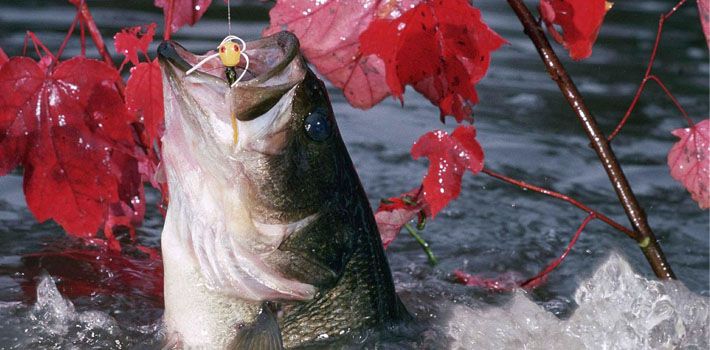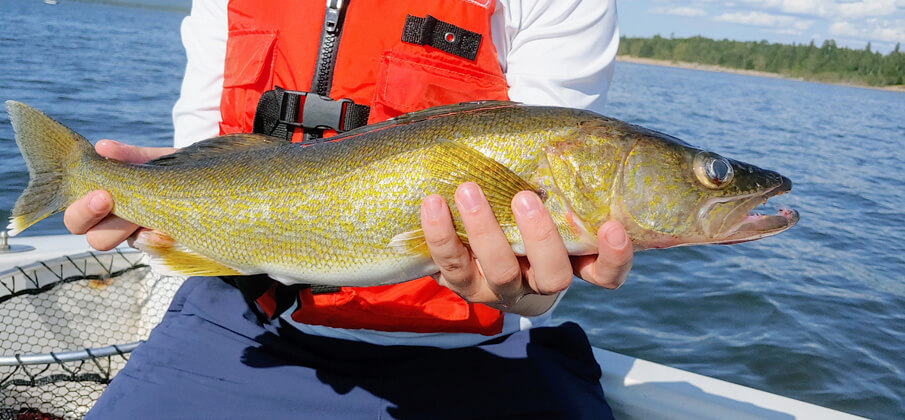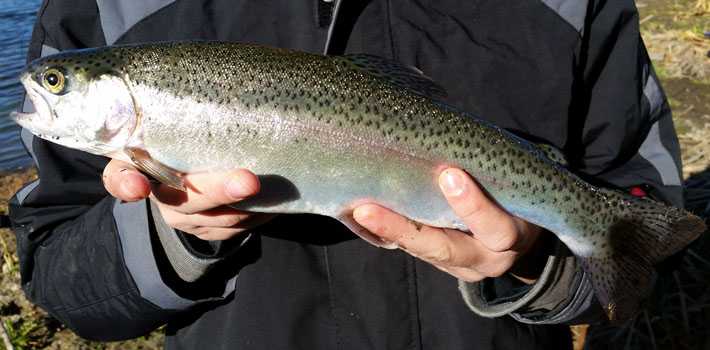Finding waters where bass is present is easy enough. But, successfully fishing for it means more than just casting the bait and waiting. Here you will learn how to fish with plastic worms on different rigs.
We will cover a few most popular rigging methods. Then, we will take a look at what kind of worms you should use to fill up your basket quickly. And finally, we will give you some extra tips.
Though it may seem simple to most people, fishing is anything but that. Before learning how to fish with plastic worms for bass specifically, make sure you have the basics covered.
So, get your supplies ready and give the techniques we’ve described a try to find your favorite!
The Rigs
1. Texas Rig

The Texas rig is simple and great for fishing around cover, such as grass where bass can be found. A medium-heavy action rod is perfectly fine for this rig. Also, high-speed gear ratio reels are very helpful.
But, remember that spending tons of money on equipment alone won’t guarantee you better results. At first, work with what you already have. And that applies to fishing in general.
For the Texas rig you will need:
Any material for the weight is acceptable - lead, tungsten, brass, etc.
- 1 First, thread the weight onto the line.
- 2Next, it's time to choose a knot and tie the hook on.
- 3Now it’s time to put the worm on:
- 1Pierce the tip of the worm head with the hook point
- 2Push the hook point out of the worm about a quarter of an inch from the tip. Make sure the knot is just inside the worm
- 3Slot the hook point into the meat of the worm farther down from the head
When you’re done, the first part of the worm should stretch straight from the knot to the hook point. That way, the second part is free to move in water. That gives it some action while submerged, which will attract the bass.
Additionally, that first part of the worm acts like a weed guard. So, there’s much less chance for the hook to get stuck in grass.
2. Shaky Head

On the Shaky Head rig, the tail of the worm stands straight up on the bottom. That makes it a bit better than the Texas rig. It’s more lifelike. For even better action, you may use a thinner worm.
Once again, work with what you already have. Learning how to fish with plastic worms is more than just following a tutorial down to a T. You will need to get out there and get some experience.
For the Shaky Head rig you will need:
You might be wondering what a shaky head hook is. The shaky head hook is a hook where the weight is integrated in the hook head. It usually has a hook keeper on it too.
- 1First, choose a knot and tie the hook to the line.
- 2Since the weight is integrated, the only next step here it to put the worm on:
- 1Slide the hook point sideways through the worm head.
- 2Push the worm head all the way up the hook, past the hook keeper. That will keep the worm on the head of the bait.
- 3Slot the hook point into the worm meat. Make sure the worm is straight across the hook, like in the previous rig.
As you can see, the only difference between this rig and the Texas rig is the hook. Though it is a simple design, it positions the worm just right to have a better appeal for the bass.
3. Wacky Rig

The Wacky Rig provides an even better presentation. On it, the worm moves naturally while it’s sinking. And when you move the rod, it has a swimming-type action. Also, the Wacky Rig is probably the most used one, because of its simplicity.
For the Wacky Rig you will need:
If you’re fishing around cover, you can use a hook with a weed guard.
- 1First, choose a knot and tie the hook to the line.
- 2Now, simply silde the hook sideways through the middle of the worm
- 3Attach the weed guard (optional)
The Wacky Rig is unique because the hook goes through the middle of the worm. Having both ends of the worm free is what gives it that natural action in the water.
The best way to use the Wacky Rig is to let the bait sink slowly. That will make the ends of the worm shake, attracting bass.
4. Drop Shot

Now, the Drop Shot rig is a more complicated method. But, it’s very effective and amazing in clear water. A spinning reel is optional, but preferred for this rig.
For the Drop Shot rig you will need:
Drop shot weights are designed to break away if you get stuck in the cover. You will lose some weights, but re-rigging will take much less time. You may use a lighter line and a smaller worm, if possible.
- 1Using a Palomar knot, tie the hook onto the line, about 10 inches from the end.
- 2Then, thread the tag end back through the eye of the hook, from the hook point side downward.
- 3Next, put the drop shot weight on:
- 1Thread the tag end through the eye of the weight.
- 2somethingsomething
- 4Lastly, put the worm on:
- 1Slide the hook point into the head of the worm from a side.
- 2Bring the hook point through the tip of the worm head so it sticks out a bit.
What makes the worm stand up when using this rig is the way the hook is threaded. The key to being successful with this rig is not to hop the bait off the bottom. When you cast the bait, let it sink and sit. Then, use light twitches of the rod tip to attract bass.7
5. Carolina Rig

Now, if you like physics or mechanics, you’ll appreciate the Carolina Rig. There’s just something beautifully technical about it. This rig keeps the bait on or near the bottom better than any other. Additionally, it covers a lot of ground.
For the Carolina Rig you will need:
Any bead will do - plastic, glass, metal, etc.
- 1First, thread the weight and the bead onto the line.
- 2Next, put the swivel on. Any knot will work.
- 3Now, tie a 14-18 inch leader to the swivel and cut the excess tag. Any type of knot is fine here, too.
- 4Then, tie the took to the leader.
- 5And now put the worm on like you would on the Texas Rig. So:
- 1Pierce the tip of the worm head with the hook point.
- 2Push the hook point out of the worm about a quarter of an inch from the tip. Make sure the knot is just inside the worm.
- 3Slot the hook point into the meat of the worm farther down from the head.
In the Carolina Rig, the bead creates noise when it clicks up against the weight and attracts the fish. It also protects the knot.
In the spring, you can use a shorter leader. And later in the year, when the grass is a little longer, make the leader longer too.
The Worms

The fishing lures come in a vast number of shapes, sizes, and colors. So, it’s easy to pick one that will reduce your efficiency when fishing.
In this part of the article on how to fish with plastic worms, we will give you some general guidelines to keep in mind when choosing a worm for your rig.
Add some contrast
This one is simple. Dark water - brighter colored worms, clear water - darker, more natural-looking worms. There’s a whole lot of biology and physics happening behind this principle. But, unless your last name is Darwin or Tesla, that’s not important. Also, remember that the weather conditions affect visibility in the water.
Size matters
In clear water, you can get away with using a smaller worm.In darker water use a bigger worm. Apart from affecting the appeal of the bait to the bass, the size of the worm also affects the sink rate.
Pay attention to the tails
The plastic worms come with a variety of tails. They’re all designed to give the bait action when submerged. Use a worm with a tail in warm water, where bass are active. Especially in dark waters and when fishing around cover. In clear, cold waters, a worm without a tail works fine.
Put on some weight
After choosing the worm size, you can fine-tune the sink rate using various weights. You want the sink rate to be slower in cold waters. So, use lighter weights in early spring and late fall. You can use heavier weights in warm water with active bass. Also, use the heavier ones when fishing around thick cover.
Quick Tips on How to Fish With Plastic Worms
Now, to round up this lesson, we’ll give you a few extra tips. However, we must remind you that learning how to fish with plastic worms, and fishing in general for that matter, takes time.
You will have to try different tactics yourself and read many more of our articles. Multiple times. Also, it’s a good idea to surround yourself with other fishermen and hear their stories.
People always relate fishing to patience, which is true. But, fishing is also about doing the right thing at the right moment. Remember the following tips to make the most out of your casts this weekend.
And there you go. You’ve now learned the basics of how to fish with plastic worms. All you have to do now is go out and try it. Like we said, you must get real experience to become a successful angler.





